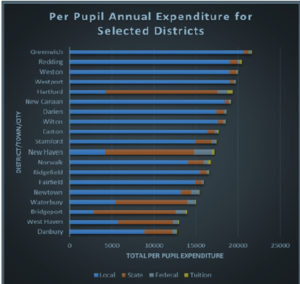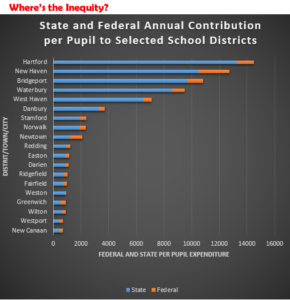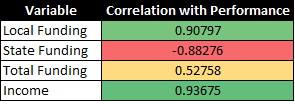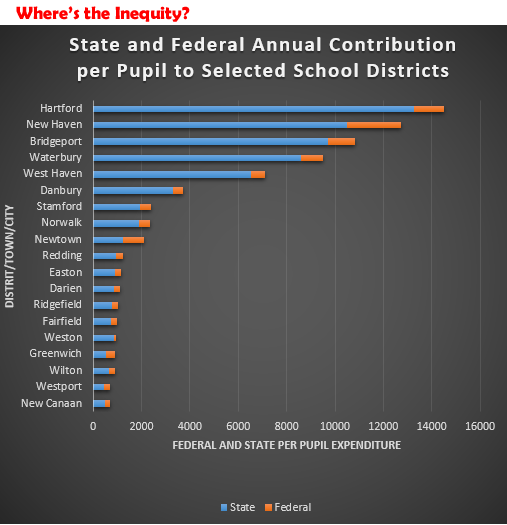Judge Thomas Moukawsher says the states funding mechanism is irrational and the state thereby failed to fulfill its mandate to thousands of schoolchildren across the state, and that the state spends this money “whimsically”, and its funding formula “irrational”, Unfortunately, this Judge’s decision can be described by those same two adjectives, and reflects a very basis failure to understand the problem, and not just this problem but the very basic fundamentals of any decision-making process. It seems that the decision was arrived at by looking at test scores and making the assumption that the only variable is that affects these scores is financial, while neglecting the fact that there are other variables which contribute to the quality of the outcomes.
Numerous variables affect testing outcomes and the quality of the education that they measure. The
sensitivity and responsiveness of the receptors (in this case, the students, the quality of support
network outside of the school and the environment in which the receptors exist just to name a few
should not be ignored. And to do so indicates a thoughtless dereliction of judicial responsibility and a
disservice to the children, exactly the accusations Moukawsher lodges against the State.
The poorest school districts are already by funded the state far in excess of the more affluent
 districts, and in terms of absolute fiscal expenditures
districts, and in terms of absolute fiscal expenditures
more is spent in these poorly-performing
schools/students than some of the highest performing
schools/students. And note that Connecticut’s
schools are consistently ranking in the top five state
school districts in the country.
In school districts in which there is high
unemployment, frequent shootings, ubiquitous drug
presence, and in which, nearly 70% of the children
are living in single-family homes, the students
perform poorly. Correlations do exist but not between
performance and the amount of financing. I believe
that the judge and our legislature are failing to
understand that this is not a financial problem, or at
least a financial problem that will be solved by hiring
more teachers and adding more facilities. The school
budget is not the issue. This is another example of
shortsightedness resulting in the misapplication of limited resources that is so characteristic of our
state and federal government.
The entire argument that has been misrepresented by the
judge and by most news outlets has been that wealthier
school districts are being subsidized at the expense of
poorer school districts. Even to extent of one commenter
stating that this is “another example of the rich screwing
the poor.” This should be evident from the first table but
just in case further clarification is necessary, the second
table represents the amount that the State and the federal
government is actually subsidizing these communities. The
CTPost says that the system has been “inequitable for
decades”. However, while the formula for funding does not
seem to be founded on a sound basis, it is not inequitable
or at least there is no evidence, statistical or otherwise to
make that conclusion. And, to further imply, as the CTPost seems to do, that there is a racial basis
for these fanciful inequities is unfortunately typical of misplaced perceptions from the President on
down.
Facts don’t lie but they certainly can be misleading especially if not presented in context or not
presented completely. For example, the State initially responded, and I think correctly, that there is
no evidence that additional funding would have any impact on the ameliorating the differences in
school/student performance among school districts. Consider the following table.
 Correlation is a statistical measure of
Correlation is a statistical measure of
interdependence or how two or more variables are
related and how they behave in relation to each
other. Correlation can be positive (i.e. if one moves
up, the other moves up) or negative (if one moves
up the other moves down). Correlation ranges from
+1 (a perfect positive correlation) to -1 (a perfect negative correlation). Thus, zero indicates no
correlation. Based on the limited data in the tables above, there is an extremely high correlation
between income and good school performance as well as with the amount of local funding. That is to
say, when the parents pay, the students perform. However, when the state pays there is a high
negative correlation. This indicates that the greater the state funding – the poorer students
perform. State funding goes up performance goes down. The relationship between overall funding
and performance is fairly weak.
Now, the first thing that one learns in the study of statistics and the thing that is drilled in constantly
as one progresses in the field of statistics is, “correlation does not equal causation.” But what this
data suggest is simply as stated above that there are other factors that influence a school’s
performance and it is foolish to think that additional funding is going to have any positive impact.
One thing that is shown in other unrelated studies is that there is a relationship between the price
paid for something and its perceived value. Things that are received gratis are perceived as being
less valuable even if the two things are exactly equal. When people pay for something, as in the
case of the better-performing schools it achieved higher perceived value, when the state pays and
the beneficiary doesn’t, then, the value is diminished.
But an important point to make here is that, the government, whether it be state or federal, doesn’t
give anyone anything. The government only takes. The state generates no revenue, it provides
nothing of value, it simply takes money from its individual constituents and buys things that those
constituents may or may not want or need, and redistributes those things. Sadly, it does so in an
inefficient, ineffective and self-serving manner, principally as a result of the same concept of
associating value with price. The government expends no level of effort, it exists solely as a result of
the value of the labors and toil of others, and the same concept holds. That which was not paid for
as a result of my labor is of diminished value.
I can go on, but; the point here is that throwing more money at a problem in the absence of any
evidence that such action will produce improved outcomes is foolish, to do so in disregard to
compelling evidence to the contrary is reckless, and; to ignore impact of any other variable is
ignorant, in the original meaning of the word i.e. “to ignore”.

